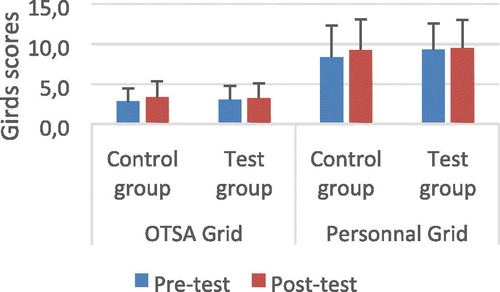Keywords:
1. Introduction
The serve is a very important shot in tennis. Many tools exist to analyse this gesture. The main goal of the tennis serve evaluation is to improve the biomechanics of the stroke.
The trophy position is a coaching cue for the tennis serve. This position usually corresponds to the racquet high point (RHP) during the preparatory action for the stroke (Whiteside et al. 2013). It has been shown that this position appears different on children compared to adults and adolescents. Mastering this position seems to characterize the most experienced players (Tubez et al. Citation2019).
The purpose of this research is to observe the effect of a training sessions of the trophy position on the biomechanics of the tennis serve gesture of children (low experienced players).
2. Methods
A 2D analysis evaluating the tennis serve biomechanics (included the trophy position) was performed on 32 children before and after 8 weeks of training.
The 32 players were evaluated at two separate times. After the pre-test, the players were randomized into a test group and a control group ().
Table 1. Groups data.
Players in the test group performed an eight-week follow-up. They performed exercises related to the trophy position during the serve training periods:
Serve performed with stop/pause in the trophy position. The child must reach this position and drop the ball on the ground without hitting.
Serve performed from the trophy position to the end.
Full serve. Trainer records the gesture with video and then shows directly to the child to indicate the points to be improved/corrected above the trophy position.
The players in the control group performed time equivalent serves exercises but without any particular attention to the trophy position. This group also received video feedback.
For the pre-test and post-test, the players performed 15 serves in an official tennis court. A radar gun evaluated the serve speed and two video cameras (side view and rear view) recording at a frequency of 50 Hz were used to retrospectively analyse the players’ movements. As proposed by Myers et al. (Citation2017), the observational tennis serve analysis method (OSTA) was used to perform the 2D biomechanical analysis of the tennis serve (Myers et al. Citation2017). A personal analysis grid was also used to evaluate specifically the trophy position. An inter-evaluator analysis was done for this grid.
A Pearson correlation coefficient and the ICC were used to compare the two grids and the two evaluators. To compare the evolution of the variables between the two groups, the Wilcoxon-Mann-Whitney test was performed (non-parametric). We considered significant results with p-value < 0.05.
3. Results and discussion
Concerning the correlation between the two grids (personal and OTSA), we obtained a Kendall correlation coefficient which is 0.74. There is a positive correlation between the scores of the two grids.
For the personal gird, we observe a good Pearson correlation coefficient between the two evaluators (r = 0.8934). The ICC (95% CI) is 0.8410 (0.791/0.947). The results observed during these tests confirm the good inter-evaluators reproducibility.
Regardless of the grid, no significant differences were observed between the groups over the times p > 0.05 (). Training of a single biomechanical parameter does not seem to improve the tennis serve of young players in the learning phase.
Figure 1. Evaluation of the tennis serve biomechanics with the OTSA scale before (pre-test) and after (posttest) the eight training weeks.

It was previously found that children have difficulty coordinating the trophy position with the maximum flexion of the dominant knee (Whiteside et al. 2013; Tubez et al., Citation2019). Although the trophy position is a key element in the tennis serve biomechanics, other parameters probably influence the final performance such as the coordination or the time sequence actions.
A difference were observed in the evolution of the ball speed between the two tests for the test group. The test group have an increased average serve speed between pre-test and post-test (p = 0.038).
All players combined (test group and control group), those with the highest scores on personal grids are also those with the highest ball speed (r = 0.77). Good control of the trophy position observed with personal grids were correlated with better performances.
4. Conclusions
Mastering the trophy position seems to be an essential parameter in the tennis serve performance. This position is difficult to control among the less good players, those who are in the learning process.
An eight-week specific training program based on the trophy position improves the tennis serve speed. Nevertheless, we have to mention that improvement cannot be observed with a 2D video analysis combined to an analysis grid.
Acknowledgements
The authors wish to thank the Federation WalloniaBrussels for its support.
References
- Myers NL, Kibler WB, Lamborn L, Smith BJ, English T, Jacobs C, Uhl TL. 2017. Reliability and validity of a biomechanically based analysis method for the tennis serve. Int J Sports Phys Ther. 12(3):437–449.
- Tubez F, Schwartz C, Croisier J-L, Brüls O, Denoël V, Paulus J, Forthomme B. 2019. Evolution of the trophy position along the tennis serve player’s development. Sports Biomech. 1–13.
- Whiteside D, Elliott B, Lay B, Reid M. 2013. The effect of age on discrete kinematics of the elite female tennis serve. J Appl Biomech. 29(5):573–582.
